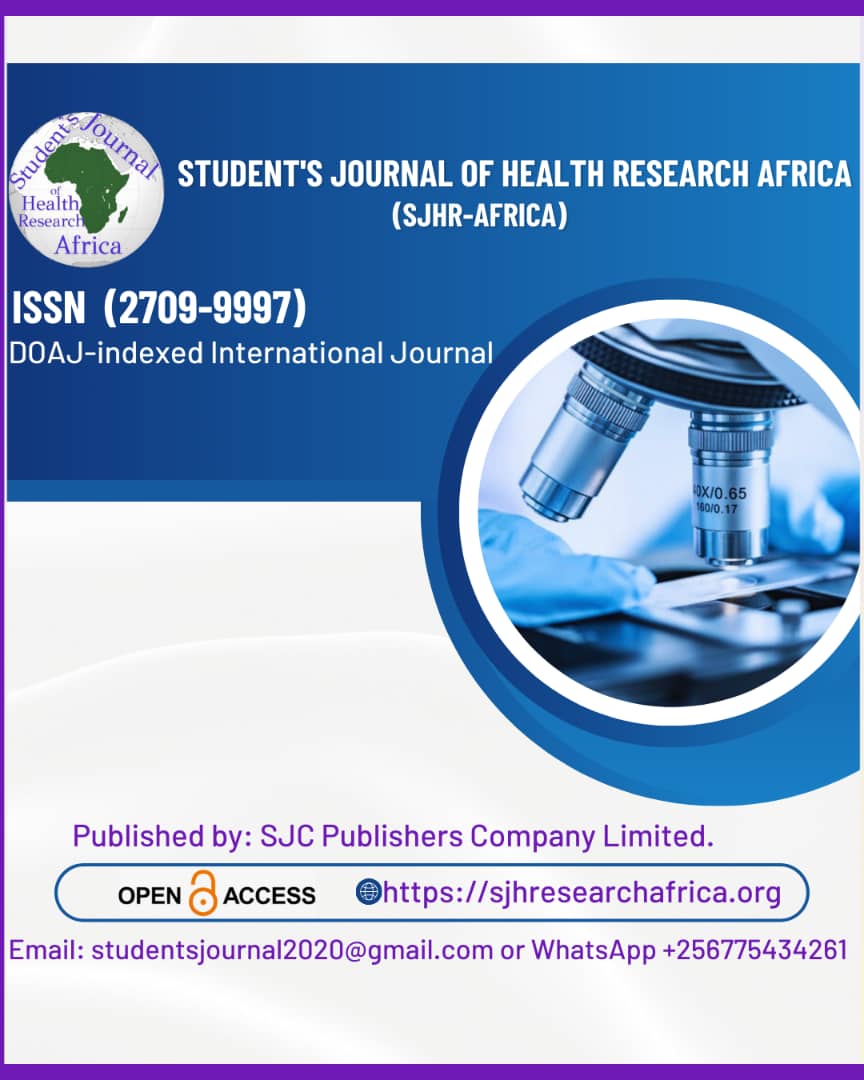Determinants of turn-up for HIV care among lactating mothers with infants at Panyadoli Health IV, Kiryandongo district. A cross-sectional study.
DOI:
https://doi.org/10.51168/sjhrafrica.v6i9.2010Keywords:
Lactating Mothers, Turn-Up, Panyadoli Health IV, Kiryandongo DistrictAbstract
Background
In Uganda, the impact of low turn-up on Lactating mothers with Infants is significant, as delays in ART adherence increase maternal viral load by 20%. The purpose of the study was to assess the Determinants of Turn-Up for HIV Care among Lactating Mothers with Infants at Panyadoli Health IV, Kiryandongo District.
Methods
A descriptive cross-sectional study design employing quantitative methods of data collection was conducted at Panyadoli Health IV, Kiryandongo District. In a duration of 5 days, 45 lactating mothers were selected using a simple random sampling method. A structured questionnaire was used to collect data, consisting of closed-ended questions. The data collected was analyzed manually, and findings were entered into a Microsoft Excel 2013, which was then presented in the form of tables, pie-charts, and graphs.
Results
The Majority of the respondents, 24(53%), were 18-30 years old. Less than half of the respondents, 16(36%), had secondary education. More than half of the respondents, 26(58%), were married, on individual determinants; 73% of mothers lacked partner support, 84% experienced stigma, 45% cited caregiving duties as a barrier to clinic attendance, and the majority 62% faced challenges due to pre-existing infant health conditions. Health facility-related determinants included lack of appointment reminders (73%), medication stock-outs (80%), and judgmental attitudes from health workers (58%). Socio-economic determinants included long distances to clinics (47%), high medication costs (67%), transport challenges (56%), and lack of support systems (51%).
Conclusion
Lack of partner support, stigma, caregiving responsibilities, medication stock-outs, long distances to clinics, and negative health worker attitudes were key factors affecting ART clinic attendance among lactating mothers with infants.
Recommendation
There is a need to strengthen partner and community support systems, improve drug availability, implement effective reminder systems, address stigma and staff attitudes, education, and advocacy to enhance ART adherence among lactating mothers.
References
Alhassan, Y., Twimukye, A., Malaba, T., Myer, L., Waitt, C., Lamorde, M., Colbers, A., Reynolds, H., Khoo, S., & Taegtmeyer, M. (2022). 'I fear my partner will abandon me': the intersection of late initiation of antenatal care in pregnancy and poor ART adherence among women living with HIV in South Africa and Uganda. BMC Pregnancy and Childbirth, 22(1), 566. https://doi.org/10.1186/s12884-022-04896-5
Altomonte, G. (2016). Beyond being on call: Time, contingency, and unpredictability among family caregivers for the elderly. Sociological Forum, 31(3), 642-662. https://doi.org/10.1111/socf.12267
Anyasodor, A. E., Ahmed, K. Y., Osuagwu, U. L., Mgbemena, N. C., Kalinna, B. H., Thapa, S., Mahmood, S., & Ross, A. G. (2023). Delays in seeking treatment for fever in children under five years of age in Nigeria: Evidence from the National Demographic Health Survey. Plos One, 18(12), e0295772. https://doi.org/10.1371/journal.pone.0295772
Arslanbek, A., Malhotra, B., & Kaimal, G. (2022). Indigenous and traditional arts in art therapy: Value, meaning, and clinical implications. The Arts in Psychotherapy, 77, 101879. https://doi.org/10.1016/j.aip.2021.101879
Bhoo-Pathy, N., Yip, C.-H., Peters, S. A. E., Kimman, M., Sullivan, R., Jan, S., Woodward, M., Ng, C.-W., Arounlangsy, P., & Aung, S. (2017). Policy and priorities for national cancer control planning in low-and middle-income countries: Lessons from the Association of Southeast Asian Nations (ASEAN) Costs in Oncology prospective cohort study. European Journal of Cancer, 74, 26-37. https://doi.org/10.1016/j.ejca.2016.12.014
Chamberlin, S., Mphande, M., Phiri, K., Kalande, P., & Dovel, K. (2022). How HIV clients find their way back to the ART clinic: A qualitative study of disengagement and re-engagement with HIV care in Malawi. AIDS and Behavior, 26(3), 674-685. https://doi.org/10.1007/s10461-021-03427-1
Changiz, T., & Namnabati, M. (2021). Management of Comprehensive Care of multiple-birth infants from fetal to infancy period: challenges, training, strategies. Bmc Pediatrics, 21, 1-9. https://doi.org/10.1186/s12887-021-02613-3
Chrapah, S. K. (2024). Health Seeking Behaviors of Pregnant and Post-Partum Women Living With HIV in a Rural Region of Kenya: Mixed Method Study. The University of Alabama at Birmingham.
Duri, K., Mataramvura, H., Chandiwana, P., Mazhandu, A. J., Banhwa, S., Munjoma, P. T., Mazengera, L. R., & Gumbo, F. Z. (2022). Mother-to-child transmission of HIV within 24 months after delivery in women initiating lifelong antiretroviral therapy Pre/Post-Conception or postnatally; Effects of adolescent girl and Young Woman Status and plasma viremia late in pregnancy. Frontiers in Virology, 2, 906271. https://doi.org/10.3389/fviro.2022.906271
Heyman, R. E., Slep, A. M. S., Lorber, M. F., Mitnick, D. M., Xu, S., Baucom, K. J. W., Halford, W. K., & Niolon, P. H. (2019). A randomized, controlled trial of the impact of the couple CARE for parents of newborns program on the prevention of intimate partner violence and relationship problems. Prevention Science, 20, 620-631. https://doi.org/10.1007/s11121-018-0961-y
Hunt, J. H., Peay, H. L., & Henderson, G. E. (2024). Facilitators and Barriers to Adherence to Anti-Retroviral Treatment Among Pregnant or Breastfeeding Women Living with HIV and Perinatally Infected Infants: A Scoping Review. AIDS and Behavior, 1-16. https://doi.org/10.1007/s10461-024-04373-4
Hwang, C. H., Iellamo, A., & Ververs, M. (2021). Barriers and challenges of infant feeding in disasters in middle-and high-income countries. International Breastfeeding Journal, 16, 1-13. https://doi.org/10.1186/s13006-021-00398-w
Kahungu, M. M., Kiwanuka, J., Kaharuza, F., & Wanyenze, R. K. (2018). Factors associated with HIV positive sero-status among exposed infants attending care at health facilities: a cross-sectional study in rural Uganda. BMC Public Health, 18, 1-11. https://doi.org/10.1186/s12889-018-5024-6
Karugaba, G., Simpson, J., Mathuba, B., Phoi, O., Regonamanye, T., Mathuba, K., Dintwa, E., Nkomo, B., Ramaabya, D., & Pule, M. R. (2022). The barriers and facilitators of HIV-exposed infant testing as perceived by HIV-positive mothers in Botswana: A qualitative study. Plos One, 17(8), e0273777. https://doi.org/10.1371/journal.pone.0273777
Langher, V., Fedele, F., Caputo, A., Marchini, F., & Aragona, C. (2019). Extreme desire for motherhood: Analysis of narratives from women undergoing Assisted Reproductive Technology (ART). Europe's Journal of Psychology, 15(2), 292. https://doi.org/10.5964/ejop.v15i2.1736
Lyatuu, G. W., Naburi, H., Mwashemele, S., Lyaruu, P., Urrio, R., Simba, B., Philipo, E., Kibao, A., Kajoka, D., & Sando, D. (2022). Effect of peer-mother interactive programme on prevention of mother-to-child HIV transmission outcomes among pregnant women on anti-retroviral treatment in routine healthcare in Dar es Salaam, Tanzania. PLOS Global Public Health, 2(3), e0000256. https://doi.org/10.1371/journal.pgph.0000256
Mannava, P., Durrant, K., Fisher, J., Chersich, M., & Luchters, S. (2015). Attitudes and behaviours of maternal health care providers in interactions with clients: a systematic review. Globalization and Health, 11, 1-17. https://doi.org/10.1186/s12992-015-0117-9
Matenga, T. F. L., Agarwal, H., Adeniran, O. P., Lam-McCarthy, M., Johnson, E. A., Nyambe, J., Chabaputa, R., Chanda, S., Habinda, D. M., & Mulenga, L. (2024). Engaging Family Members to Support Exclusive Breastfeeding, Responsive Care, and Antiretroviral Therapy Adherence Among Families with Children who are HIV-Exposed and Uninfected in Malawi. AIDS and Behavior, 28(12), 4052-4068. https://doi.org/10.1007/s10461-024-04467-z
Mazele, O., & Amoah, C. (2022). The causes of poor infrastructure management and maintenance in South African municipalities. Property Management, 40(2), 192-206. https://doi.org/10.1108/PM-06-2021-0042
Mburu, B. W. (2021). Missed Opportunities for Early Diagnosis of Hiv in Hiv Exposed Infants and Children 0-18 Months at Kiambu Level V Hospital. UON.
McLeish, J., Harrison, S., Quigley, M., & Alderdice, F. (2022). Learning from a crisis: a qualitative study of the impact on mothers' emotional wellbeing of changes to maternity care during the COVID-19 pandemic in England, using the National Maternity Survey 2020. BMC Pregnancy and Childbirth, 22(1), 868. https://doi.org/10.1186/s12884-022-05208-7
Mpinganjira, S., Tchereni, T., Gunda, A., & Mwapasa, V. (2020). Factors associated with loss-to-follow-up of HIV-positive mothers and their infants enrolled in HIV care clinic: a qualitative study. BMC Public Health, 20, 1-10. https://doi.org/10.1186/s12889-020-8373-x
Nanyeenya, N., Nakigozi, G., Siu, G., Kiwanuka, N., Makumbi, F., Nasuuna, E., Nabadda, S., Kiyaga, C., Kibira, S. P. S., & Nakanjako, D. (2024). Exploring the knowledge and perceptions of viral load testing and low-level viremia among health-care workers in Uganda: A qualitative study. Advances in Global Health, 3(1). https://doi.org/10.1525/agh.2024.2315085
Nguyen, H., Nguyen, T., Tran, D., & Hinton, L. (2021). "It's extremely hard, but it's not a burden": A qualitative study of family caregiving for people living with dementia in Vietnam. PloS One, 16(11), e0259788. https://doi.org/10.1371/journal.pone.0259788
Nyasulu, J. Y.-K. (2016). Pre-ART program service delivery at a PHC facility level: Access and retention of patients in care in the city of Johannesburg, South Africa.
Page, B. F., Hinton, L., Harrop, E., & Vincent, C. (2020). The challenges of caring for children who require complex medical care at home: 'home: 'home: 'The go between for everyone is the parent, and as the parent, that's an awful lot of responsibility.' Health Expectations, 23(5), 1144-1154. https://doi.org/10.1111/hex.13092
Phillips, T. K., Teasdale, C. A., Geller, A., Ng'eno, B., Mogoba, P., Modi, S., & Abrams, E. J. (2021). Approaches to transitioning women into and out of prevention of mother‐to‐child transmission of HIV services for continued ART in Tanzania: a systematic review. Journal of the International AIDS Society, 24(1), e25633. https://doi.org/10.1002/jia2.25633
Sornillo, J. B., Ditangco, R., Kinikar, A., Wati, D. K., Du, Q. T., Nguyen, D. Q., Khol, V., Nguyen, L. Van, Puthanakit, T., & Ounchanum, P. (2023). The changing characteristics of a cohort of children and adolescents living with HIV at antiretroviral therapy initiation in Asia. Plos One, 18(9), e0291523. https://doi.org/10.1371/journal.pone.0291523
Statz, M., & Evers, K. (2020). Spatial barriers as moral failings: what rural distance can teach us about women's health and medical mistrust. Health & Place, 64, 102396. https://doi.org/10.1016/j.healthplace.2020.102396
Theunissen, H. C. (2020). Early infant breastfeeding practices, and predictors of breastfeeding cessation, in HIV-uninfected and HIV-infected mothers on antiretroviral treatment: a prospective cohort study. African Journal of AIDS Research, 234(1), 21-27.
Wang, X., & Cheng, Z. (2020). Cross-sectional studies: Strengths, weaknesses, and recommendations. Chest, 158(1), S65-S71. https://doi.org/10.1016/j.chest.2020.03.012
Downloads
Published
How to Cite
Issue
Section
License
Copyright (c) 2025 Rebecca Tusiime, Hasifa Nansereko, Immaculate Prosperia Naggulu, Jane Frank Nalubega

This work is licensed under a Creative Commons Attribution-NonCommercial-NoDerivatives 4.0 International License.





















